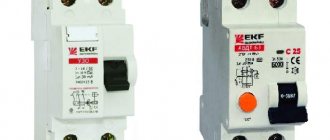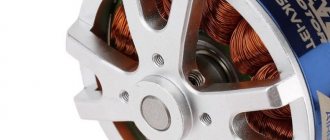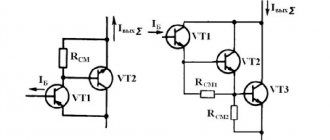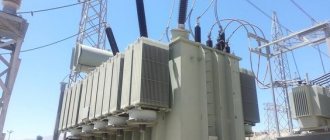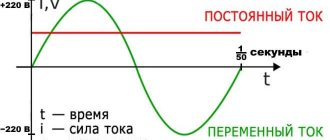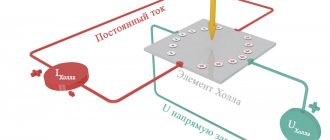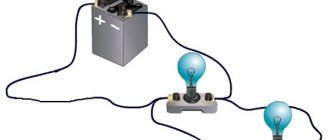Most people are not very well versed in the types of electrical protection devices, so they often do not understand the difference between them. In fact, these devices are designed to solve different problems, and therefore even an ordinary resident needs to know how they differ and what function they perform, at least in general terms. An RCD is often confused with a differential circuit breaker. After reading the article presented to your attention, you will learn what is the difference between an RCD and a difavtomat, and you will also be able to understand when and which of these devices is better to install.
RCD and differential circuit breaker: tasks performed
If you put an RCD and a breaker next to each other, their similarity will be immediately noticeable. Indeed, such devices are easy to confuse. But they perform different tasks. The RCD provides protection for people and pets from electric shock - this is its only function. If the power line or any of the devices connected to it are damaged, leakage current may appear in the circuit. If you touch such wiring, you can receive a strong electric shock.
In addition, an electrical leak can cause the insulation to overheat and subsequently melt, which often leads to a fire. Installing an RCD will solve this problem - when a leakage current is detected, it will operate and the circuit will be disconnected. After troubleshooting, the device can be turned on again.
However, this device does not provide protection against all possible problems with the cable. Protecting the line from leaks, it does not respond to overloads or short-circuit currents. To avoid these problems, it should only be installed together with a circuit breaker. Another option is to connect a differential circuit breaker to the power supply instead of an RCD.
The difference between the devices is clearly shown in the video:
First, let's explain what a difavtomat is. This is the name of a protective device that is capable of simultaneously performing the work of an RCD and an AV. Thus, he will be able to save the line from any possible disturbances (current leakage, short circuit, overvoltage). Simply put, this is a regular circuit breaker for an electrical network with an RCD included in it.
The residual current device itself can be compared to a leak indicator, which will show whether electricity is flowing to consumers or going outside. There is a leak - the RCD trips and de-energizes the network.
If it is not there, the device will not notice any overload or short circuit. Therefore, if you are thinking about what you still need - an RCD or a circuit breaker, and do not know what to choose to protect your home line, then remember: the first is not a self-sufficient device and cannot be installed in a line without a circuit breaker. The difavtomat itself can protect the network from the problems described above and does not require additional equipment.
Possible malfunctions and causes of operation
It is obvious that in the event of a malfunction of the RCD or the automatic circuit breaker, as well as the circuit breaker, the lives of users are in danger. Therefore, this issue should be given special attention.
The functionality of the RCD - both stand-alone and part of the circuit breaker - can be checked by pressing the "TEST" button. However, it must be taken into account that such a check is not exhaustive, in other words, complete. An RCD can be triggered by pressing this button, but at the same time be faulty:
- the disconnecting current may exceed the value specified in the passport;
- the response time can be more than 40 ms (if the device is turned off for a long time, the current will have time to cause cardiac fibrillation if a person is injured).
In addition, proper operation of the TEST button is not sufficient proof that the device is connected correctly.
To guarantee the serviceability of the RCD, you need to connect it and generate a test current leak of a threshold value. Such testing should only be carried out by specialists.
The part of the automatic machine that protects against overload does not have a test button. So you can check its serviceability only by installing a short circuit or connecting a device whose power exceeds the permissible one. However, with such a check, a user who does not have special equipment will not be able to understand whether the response time corresponds to the value specified in the passport.
Therefore, an important conclusion should be made: the user cannot conduct an exhaustive check of the protection devices for serviceability, therefore it is extremely important to avoid purchasing counterfeits. Buy RCDs and automatic devices only in large, trustworthy stores. If you had to make a purchase in a small store or at the market, at least ask to see a certificate.
The simplest versions of electronic RCDs (remember that there are also electromechanical ones) may be serviceable, but inoperative. This situation occurs when the neutral wire above the device is broken (or disconnected from the neutral bus, which happens more often). The fact is that the amplifier of such an RCD is volatile and is included in the protected circuit in parallel with other loads.
If the neutral wire breaks, a phase appears on all contacts of the devices, so the electronic RCD will not work, and a person may receive an electric shock
It is clear that when the zero line is disconnected, not a single electrical device, including an amplifier, can work, but at the same time the phase conductor and all current-carrying parts connected to it remain energized. That is, the possibility of electric shock exists, but the electronic RCD will not work and will not disconnect the circuit.
Improved electronic RCDs and automatic devices equipped with a safety mechanism do not have this drawback. They turn off the device if the amplifier is left without power for any reason.
This is the type of device you should buy. The most “advanced” of them can turn on independently after the power supply to the amplifier is restored. Without this function, the difavtomat or RCD will have to be turned on manually every time after the light is turned off.
Now a few words about why RCDs and automatic devices can trigger spontaneously. Most often this is due to several reasons.
Video: how to distinguish a real automatic machine from a fake
Current leakage in the network
Leaks may occur due to:
- old wiring. If the insulation of the wires has cracked over time, and in some places has even completely fallen off (this can often be seen in old houses), then in damp weather the total amount of leaks may well reach the triggering threshold of an RCD or a circuit breaker. Leakage can also occur due to insects or small animals touching uninsulated areas;
- errors during wiring installation. When carrying out repairs, residents, as a rule, lay the wires themselves and, out of ignorance, often violate installation rules. For example, they connect wires using twists, which are also poorly insulated or not insulated at all (when laid hidden). If work is carried out carelessly, the insulation can easily be damaged - current leakage may also periodically occur in such a place;
Connecting wires using cold twist is not allowed by current standards and Electrical Installation Rules (PUE)
- connecting the grounding wire to the neutral wire in the area protected by the RCD or automatic circuit breaker. Usually the jumper is installed in the socket, thus performing grounding. When the load is turned on, the protection device will definitely work: part of the current will flow through the grounding conductor, as a result of which the currents passing through the phase and neutral poles of the RCD will be different.
An RCD can be triggered if the solution used to seal the groove with the laid wire has not yet dried. The moisture contained in it penetrates the wire through the smallest defects in the insulation, thus causing current leakage. You need to wait for the mixture to dry completely and only then turn on the protection devices.
Incorrect connection of the RCD or breaker
In order not to make a mistake when connecting a circuit breaker or RCD, it is important to understand the operating principle of this device. It's simple. The main component is a differential transformer, which contains three coils:
- the first and second are connected respectively to the phase and neutral conductors in such a way that the currents flowing in them have different directions;
- the third is connected directly or through an amplifier to a trip relay.
If the currents on the phase and zero lines are equal, then the electromagnetic fields arising in the corresponding coils of the differential transformer will be equal. Therefore, they will compensate each other. If the currents differ, a residual electromagnetic field will appear, which will induce an EMF in the third coil, and it will turn off the relay.
Hence the main rule: all the current that enters the protected circuit through the phase pole of the RCD / automatic circuit breaker must exit only through its zero pole, and in no case should current be “mixed” with it from the outside.
Those who have a rather vague idea of the RCD device may make the following mistakes:
- The neutral conductor from the protected circuit is connected, bypassing the RCD (differencing circuit breaker), directly to the common neutral bus. It is clear that under such conditions the field from the current flowing through the phase pole will not be compensated (the zero pole is not connected to anything at all), and the device will disconnect the circuit when the load is turned on. This erroneous connection option is called open-phase.
- Often there are several groups of machines in the network, each of which is protected by its own RCD. In this case, an inexperienced installer can connect the “zero” from one group to an adjacent RCD and vice versa. As a result of such an error, both RCDs will trip when the load in any group is turned on.
- A similar situation will arise if a “zero” from any other load is connected to the “zero” of the protected circuit below the RCD - the additional current will provide a difference to which the switch will definitely respond. This error is not uncommon. Specifically, they do the following: install a zero bus, to which “zeros” are connected not only from the protected circuit, but also from neighboring ones; then the conductor from this bus is led to the lower (that is, from the load side) zero contact of the RCD.
- Sometimes one of the poles is connected correctly, and the other - vice versa. As a result, the currents in the differential transformer coils will flow in one direction, and regardless of their ratio, the device will turn off. To avoid confusion, always connect the wires from the power line at the top (fixed contacts) and the load side at the bottom (moving contacts).
In case of some errors, the “TEST” button will work as if nothing had happened; in others, the automatic machine will not respond to its pressing.
There are two conclusions from this:
- do not rely entirely on this mechanism - carefully study the diagram and try to follow it;
- If the connected automatic machine does not work when you press this button, do not rush to throw it away - perhaps it is due to an incorrect connection.
The “TEST” button is intended for an initial check of the functionality of the RCD module or circuit breaker, but if it does not work, this does not mean that the device is faulty - the reason may be an incorrect connection
The leakage current setting of the RCD/breaker is too low
The thing is that an RCD with high sensitivity - the leakage current setting is 30 mA or lower - may cause false operation when too high currents flow through it. If you are faced with such a problem, you can install a low-sensitivity RCD (fire protection) at the input, and then divide the circuit into several groups with lower rated currents and provide each of them with a switch with acceptable sensitivity.
The difference in appearance between an RCD and a differential circuit breaker
Determine which device is in front of you - an RCD or a differential device. automatic – quite easy even visually. Despite the external similarity (switch lever, the presence of a “Test” button, the same body part with a diagram printed on it, as well as numbers and letters), it is enough to look closely to see that the designations on these devices are different. We'll talk about this below. It’s even easier to determine whether the RCD or the automatic circuit breaker is in front of you by the location of the “Test” button and switch. For RCBOs, the lever is located on the left, the button is on the right, but for RCDs it is the other way around. This can be clearly seen in the above photograph.
RCD feature
However, you need to understand that there are scenarios in which the RCD simply does not respond. These, for example, include cases of animals coming under voltage, when there is no short circuit to the ground. This scenario is quite possible when there is simultaneous contact with the phase and neutral conductors. In addition, this can also happen if there is insulation with the floor.
This feature is due to the fact that the RCD is simply not capable of distinguishing the current that passes through an animal or person from the one that is usually present in the load element. Here you can only use mechanical protection or de-energizing before direct contact, if such is planned. This problem is also partially solved by a plug-in circuit breaker, with which the RCD works in tandem, which provides protection against leaks and overloads, but more on that later.
RCD and differential automatic device: differences in markings
The next question is: how to distinguish an RCD from a difavtomat by one of the signs - the markings applied to its body part.
On the surface of the RCD, the rated current is indicated exclusively by numbers. The Latin letter (B, C, D) in front of them is an integral feature of the RCBO.
Let's look at the above photo again. The body part of the RCD is marked “16A”. It means that the rated current in the circuit in which this device is connected should not exceed 16A. RCBOs designed for a similar rated current are marked “C16”. The letter indicates the characteristics of the built-in releases.
Several ways to distinguish an RCD from a difavtomat in the video:
Connection
Here it is worth mentioning the differences between connecting an ouzo and a machine with a difautomatic machine. This must be taken into account, if only because the connection speed determines not only the installation time, but also repair or replacement in case of problems.
So, the RCD is connected like this: the phase wire is connected to the circuit breaker, which comes out of it and is connected to the RCD terminal. After which the neutral wire is connected to the upper terminal, and the phase and zero move from the lower part to the consumer.
If we consider a difavtomat, then everything is much simpler: the wire - phase and neutral - is connected to the upper terminals, and from the lower ones everything immediately goes to the consumer. Thanks to this option, installation or replacement time can be significantly reduced.
Differences between devices according to the electrical circuit
The circuit is applied to many devices. When looking at the RCD or differential. machine, you will notice that the diagrams printed on them are similar, but not identical. There is an oval on the VD diagram - this symbol indicates a differential transformer, which is the main part of the device. It is responsible for detecting leakage current. The distinctive symbols on the RCBO diagram include the designations of releases - an electromagnetic solenoid and a bimetallic plate, which ensure that the circuit breaker operates when short-circuit currents or overloads appear in the circuit.
There are no release symbols on the residual current device.
Space Occupied
First, we note that, in principle, the issue of space should not arise in a proper electrical system. If there is not enough space for something, then the shield needs to be updated and everything that is needed installed. However, when we choose between an RCD and an RCD, we will also have to take into account one aspect of how an RCD differs - an additional module.
This is justified by the fact that the RCD completely lacks built-in overcurrent protection. The consequence of this is the mandatory installation of a circuit breaker that will protect it. As a result, it turns out that installing an RCD takes three modules.
If the main device is an automatic machine, then it will take up only two places. This difference is not too great, but often the installation of at least two or three modules is required, not counting their further increase. In such a strategic perspective, it is simply impossible to visually determine in advance how much space will be needed for each module. That is why you need to either save or expand space.
Abbreviation on the body
Since manufacturers know that ordinary people are often confused about these devices, many of them put the corresponding abbreviations on the side of the case. The residual current device corresponds to the letters VD (differential current switch), the technical abbreviation of the difavtomat is AVDT (which means automatic differential current switch).
This sign allows you to accurately understand what a specific device is - an RCD or a differential circuit breaker. Unfortunately, such designations are found only on devices from Russian manufacturers; imported devices do not have this marking.
Difavtomat or RCD - which is better?
And first of all, it is necessary to clarify: a differential circuit breaker is no better or worse than an RCD, and vice versa. The choice should be based on the specific tasks and conditions in which they will be used.
A clear example in this part will be that if a differential circuit breaker turns off all or part of the wiring in the event of an overload or short circuit, then the RCD will do the same, but in the event of a current leak. To put it simply, metering usually means insulation damage when current “leaks” into the ground, which is important when conductive elements hit the ground or anywhere else. This does not apply to the normal operation of the device and also poses a danger to people and their property. Ideally, it is recommended to install the devices together, as one complements the other.
As a result, the choice between the two systems, if you approach it too categorically, does not make any sense at all, since it is often impossible to predict the cause of the problem. However, if there is absolute confidence that a network overload is more likely to occur than a current leak, and vice versa, then choosing between an RCD and a differential circuit breaker makes sense.
RCD and differential AV: which of these devices to choose?
So, we figured out how an RCD differs from a difavtomat. Now let’s move on to the question that is often asked on forums: “Which is better – an RCD or a differential?” Indeed, considering that the RCBO consists of two devices in a complex, provides reliable protection of the network from leaks, overloads and short-circuit overcurrents, without requiring additional devices, we can come to the conclusion that in any case it is necessary to install a difavtomat.
But it is not so. Let's look at this in more detail.
As for the price, the RCBO is more expensive than the residual current device. However, the total cost of the RCD and AV is higher than that of a differential circuit breaker. In this regard, buying the latter is more profitable.
In terms of operational reliability, these devices are identical. Only devices from different manufacturers may differ. Russian-made devices cannot be called bad, but they are still inferior to most foreign analogues in response time, and the quality of the material from which the body part of domestic products is made is worse. Naturally, the price of imported devices is higher than those produced in Russia.
Now let's talk about the disadvantages inherent in RCBOs as a combined device. If the RCD and the circuit breaker are installed separately, then in the event of a problem in the circuit, one of them is triggered: in the event of a leak, the VD, and in the event of an overload or a short circuit, the AB. This greatly simplifies troubleshooting. If the automatic switch works, you will have to spend a lot of time to find out the reason for its shutdown. True, taking into account this feature, some modern RCBO models are equipped with operation indicators that allow you to determine why the device was turned off.
Another possible problem is breakdown. Any equipment can break down, protective devices are no exception. If one of the devices in the RCD-AV chain fails, replacing it will cost less than installing a new automatic circuit breaker. In this case, one of the parts of the RCBO may become unusable, and the entire device will have to be replaced. Therefore, when choosing between these devices, you need to take into account the stability of the network and the risk of possible problems.
As for ease of installation, the RCBO is preferable in this regard - installing it in a switchboard is easier and faster than two devices.
Possible errors when connecting RCDs and breakers on video:
dimensions
It is worth noting that the devices have a modular design; they can be mounted on a DIN rail, which will significantly reduce the space required for installation in an apartment or in any electrical panel. But it should also be noted that even this approach cannot always eliminate the lack of space for equipping electrical wiring with other protection devices.
The RCD and the circuit breaker are usually manufactured in separate housings. Installation is also carried out separately. But they can be installed on the same rail. As for the differential circuit breaker, it is housed in one housing. In other words, it contains two complex devices at once. Together they provide reliable protection. Differences diff. machine and RCD are essential, we will talk about them later in the article.
This point must be taken into account when creating a project for electrical work in a new house or apartment. Based on this, it is necessary to select shields and provide a small amount of space in case the circuit suddenly needs to be modified. But when reconstructing electrical wiring or minor repairs, electrical panels are not always replaced. Therefore, the problem of lack of space in them remains.
Criteria for selecting electrical protection devices
Let's try to figure out what is better for the home - an RCD or a differential circuit breaker, and consider various installation situations. Most often, the choice is influenced by factors such as the position of the device in the electrical panel, the nuances of connecting to power lines, and the possibility of maintenance or replacement.
Features of installation in an electrical panel
An electrical panel is a metal box, inside of which protection devices and an electric meter are usually located. The working panel to which the devices are attached is limited in size.
If the electrical network is improved and additional modules are installed, then there is a shortage of free spaces on the DIN rails. In this case, difautomats find themselves in an advantageous position.
Layout of “automatic + RCD” pairs on the DIN rail (top row) and automatic circuit breakers (bottom row). Obviously, lower units take up less space. The difference will increase if the protection is designed for a larger number of circuits
Modern equipment of apartments with electricity is focused on increasing the number of circuits. This is due to the emergence of a large number of powerful equipment, and to the division of the network into many lines. In such a situation, in the absence of additional space, the only reasonable solution is to connect difavtomats.
When selecting devices, pay attention to devices that occupy one module-space. Such models have already appeared on sale, but their cost is slightly higher than traditional ones.
Difficulty connecting wires
The main difference in connection between the two indicated options is the number of wires. Two separate devices have more terminals in total - 6 pieces, while the difavtomat has only four. The connection diagram is also different.
Comparative diagram of installation and connection of a protective pair and a difautomatic device. The result of operation in an emergency situation and the reliability of the devices are the same, but the order of connecting the wires is different
The diagram clearly shows the wiring connections.
When connecting a pair of AB + RCD, the situation is as follows:
- the phase wire is connected to terminal AB;
- the output of the machine and the L-terminal of the RCD are connected by a jumper;
- the output of the RCD phase is sent to electrical installations;
- the neutral wire is connected only to the RCD - at the input with the N-terminal, at the output - it is sent to electrical installations.
With a difavtomat, the connection is much simpler. Jumpers are not needed, just connect phase and neutral to the corresponding terminals, and send them from the outputs to the load.
What does this give to the installer? Facilitates the connection process, reduces the number of wires, and, accordingly, guarantees more order in the electrical panel.
How is triggering diagnosed?
If we consider devices from the middle price segment, then the tandem “automatic device + RCD” has advantages. Suppose there was an emergency power outage on one of the circuits.
It is difficult to immediately determine the reason for the protection to operate, since it could be a leakage current, a short circuit, or a total load that the wires could not cope with.
When an RCD or circuit breaker is triggered, you can immediately see where to look for the cause. In the first case, there is an insulation problem, in the second, there is an increased load or a short circuit. The latter can be determined by additional characteristics
If the automatic machine responded to a network failure, then it will take longer to look for the cause. It is necessary to check all versions, and this will take more time and effort.
To simplify diagnostics, it is recommended to purchase devices from a more expensive price segment - they are equipped with additional indications indicating a possible problem.
Which devices are cheaper to buy and repair?
There are situations where the choice is based on cost. For example, there is a budget that cannot be exceeded. In this case, the total cost of all connected protection devices plays a decisive role.
At first glance, a larger number of devices are characterized by a higher price. In fact, everything is different: a universal automatic machine costs a tidy sum, but a set of other devices turns out to be economical.
If you monitor the price tags of all the designated machines, it turns out that one automatic machine is almost twice as expensive as the “AV + RCD” set
It should be remembered that the number of lines is usually 3 or more, so the difference between purchases increases. If for one circuit the purchase of RCBOs is only 1 thousand rubles more expensive, then for five circuits the difference in amounts grows to 5 thousand rubles.
Thus, both automatic devices and RCD units with circuit breakers have their advantages and disadvantages. If RCBOs win in compactness and ease of connection, then they clearly lose in diagnostics and cost accounting.
Load disconnect switching devices
If the electrical system of an apartment or house is divided into separate circuits, it is recommended to equip each line of the electrical circuit with a separate circuit breaker, and install an RCD at the output.
However, there are many more connection options, so first you need to understand the difference between an RCD and a differential circuit breaker, and then carry out the installation.
Circuit breakers - modified “plugs”
When there was no question of a variety of protective devices, when there was excessive load on the line, “plugs”—the simplest emergency devices—triggered.
Their functionality has been improved and circuit breakers have been created that operate in two cases - when a short circuit occurs and when the load increases close to critical.
The design of the machine is simple: several functional modules are enclosed inside a case made of durable technoplastic. On the outside there is a lever for closing/opening the chain and a mounting groove for “fitting” on the DIN rail (+)
One electrical panel can contain one or several switches, their number depends on the number of circuits serving the apartment or house.
The more separate lines, the easier it is to replace or repair electrical devices. To install one device, you do not need to disconnect the entire network.
A prerequisite for assembling a home electrical network is connecting the machine. Breakers trip quickly when the system is overloaded and due to a short circuit. The only thing they cannot protect against is leakage currents.
RCD – automatic protection devices
It is the RCD that is the device that automatically analyzes the current strength at the input/output and protects against leakage currents. The shape of the body is similar to a circuit breaker, but it works on a different principle.
Inside the housing there is a working device - a core with windings. The magnetic fluxes of the two windings are directed in opposite directions, which creates balance. Thus, the magnetic force in the core is reduced to zero.
As soon as leakage current occurs, a difference in magnetic flux values appears - the output value decreases. As a result of the interaction of the flows, the relay is triggered and breaks the circuit. The response time interval is within 0.2-0.3 seconds. This time is enough to save a human life.
External distinguishing features are the presence of additional terminals (the machine has 1 piece at the top and bottom), a test button, a wider front panel, and different markings (+)
On the case you can see the markings 10 ... 500 mA. This indicates the rated leakage current. For home use, an RCD with a rating of 30 mA is usually chosen.
Devices marked 10 mA can be useful if a separate circuit is routed to a children's room or bathroom where there is a high level of humidity.
The RCD protects against leakage currents, but is useless with increased load on the wires, and also will not help in the event of a short circuit. For this reason, two devices - an RCD and a circuit breaker - are always mounted in pairs.
Only together will they provide a full degree of protection, which must be present in every household electrical system.
Differential automatic – maximum protection
When we talk about how an RCD fundamentally differs from a differential circuit breaker, we mean not a separately installed RCD device, but a pair of “RCD + switch”.
An automatic residual current switch (RCCB), in its essence, is this pair, but combined in one housing.
Thus, it immediately performs three main functions:
- protects against leakage currents;
- prevents line overload;
- Instantly triggered in the event of a short circuit.
Despite its small size, the device operates efficiently and quickly, but under one condition - if it is produced under a reliable, proven brand.
If you do not know the nuances of the device and the symbols placed on the body, a difavtomat can easily be confused with an RCD. One of the clues is the RCBO marking (+)
The technical documentation, which is necessarily attached to the device, lists its characteristics. The designation of the most important indicators is printed on the front side of the case.
In addition to the name marking, the rated load current and leakage current are indicated here. The units of measurement are the same as for simple machines - mA.
At first glance, it may seem that the appearance of a difavtomat completely negates the initially existing “switch + RCD” circuit. However, there are many nuances that govern the choice of one solution or another, and as a result, both installation schemes are relevant and in demand.
Advantages and disadvantages
Each of the devices has its own advantages and disadvantages. It is better to use them together, but if this cannot be done, then you will have to come to terms with some of the operating features of the devices.
Difavtomat
The advantages are as follows:
- small size;
- possibility of installing a smaller shield;
- inexpensive and simple installation process;
- no need to use any special devices during installation.
Residual current device in the distribution box
There are also disadvantages:
- sometimes it is difficult to detect the cause of the trigger;
- if a zero break occurs, then a current still flows through the phase, which can affect a person;
- difficulty in identifying device malfunctions.
RCD
The RCD also has a couple of advantages:
- mounting with a machine allows you to be 100% sure of one reason or another for its operation;
- failure of the protection means simply eliminating the old device and replacing it with a new one;
- The device is quite easy to install.
Now about the cons:
- the residual current device needs to protect itself;
- triggers only when there is a leak;
- inability to perform network protection functions if the accident is associated with overloads or short circuits.
Automats in the shield
By network type and leakage current
Differential circuit breakers according to the type of controlled electrical network are divided into single-phase with a voltage of 220 V and three-phase with a linear voltage of 380 V, respectively, divided into two-terminal circuits for single-phase and four-terminal circuits for three-phase networks.
Depending on the leakage current occurring in the controlled network, difavtomats, like RCDs, are divided into the following categories.
AC type. A differential machine of this type reacts to a sinusoidal alternating leakage current, which can appear instantly or increase gradually.
When the trip current threshold value is exceeded, it is triggered, breaking the protected line. On the body of the difavtomat there must be an AC designation or an alternating current symbol in a frame.
Type A. The difference between a device in this category and the first type is that it reacts to the instantaneous occurrence or gradual increase of alternating and direct (pulsating) leakage current. When the set value is reached, the automatic switch is activated.
On its body there should be an image of the letter A or a symbol of a sine wave and a pulsating current in a frame. The differences affect the price. These automatic devices are much more expensive than devices of the first type due to the need for additional control and pulsating currents.
They are the most widespread and recommended in most cases. This is due to the large number of household appliances that have exactly this kind of leakage current. Some manufacturers directly indicate this type of protective devices for their devices.
Type B. Automatic devices of this type are triggered in the presence of alternating, direct or rectified leakage current. Regardless of how the threshold value is exceeded, instantly or gradually. Typically used in industrial facilities.
On the case, symbols of direct, alternating and pulsating currents are indicated in a frame, as in an RCD (by the way, in the West it is usually called a difrele).
Installation of circuit breakers
To provide comprehensive protection, an additional circuit breaker must be installed together with the RCD. It is a special device with the help of which a current of the required strength is carried out in the normal state of the circuit, when there is no excessive load in the electrical network.
If a short circuit or excessive load occurs during operation of the equipment, the circuit breaker completely de-energizes the network, but it does not operate in the same way as standard circuit breakers or fuses, which are designed for an increased number of operation cycles.
You can also find a large number of models on the market that are also triggered when other disturbances occur in the network (for example, a sharp drop in voltage).
Such equipment is installed inside electrical panels or cabinets, where it is mounted on special DIN rails.
Electromechanical or electronic – which is better?
By analogy with RCDs, difavtomats are manufactured either with an electromechanical residual current device or with an electronic one.
The electromechanical device does not require additional power supply to operate. The energy to activate the trip coil, which removes the automatic device from the on state, is taken from the source of the leakage current. Therefore, the differential transformer that registers these currents in electromechanical devices has large dimensions. Its task is not only to sense the leak, but also to convert its small value into a voltage sufficient to trigger the device.
The large dimensions of the transformer increase the size of the device as a whole. Therefore, the volume they occupy in the panel is greater than that of electronic ones .
Electronic automatic devices, in addition to a leakage current sensor and a tripping coil, contain an electronic circuit with a signal amplifier. A small signal from the sensor increases to an amplitude and power sufficient to operate the release coil.
These automatic machines are more compact, but does that mean they are better? In fact, their advantages are limited to compactness. There are situations in which this device will not help.
Electrical faults
The main function of all protective devices is to eliminate possible faults that periodically occur in electrical networks. First of all, they provide protection against short circuits caused by a decrease in the electrical resistance of loads to very low values. The main reason for this condition is the shunting of voltage circuits by metal objects.
Another common malfunction is related to overloading of wires under the influence of powerful modern electrical appliances. As a result, the appearance of large currents leads to increased heating of the wires, especially in low-quality networks. At the same time, overheating and aging of the insulation occurs, with the loss of its dielectric properties. In this regard, another type of fault occurs, known as leakage currents, arising from broken insulation.
Often the situation worsens further due to the use of old aluminum wiring, which is operated under critical conditions of constant increased loads. However, even new systems can malfunction due to poor installation and ineffective protective devices used inappropriately.
Reliability under failures
Now regarding technical behavior during a power outage. So, if the RCBO turns off, you will need to find the reason. There are three of them in total:
- leakage current;
- short circuit;
- overload.
A person who is familiar with the topic will need about an hour to determine the exact reason for the circuit breaker tripping and about the same amount to eliminate it. In the case of an RCD and an automatic device, everything is much simpler, since it has fewer protective functions. If it turns off, then the problem is a current leak - there simply cannot be any other options.
The differences from ouzo in this case are colossal. This especially applies to people who do not understand electrical engineering.
